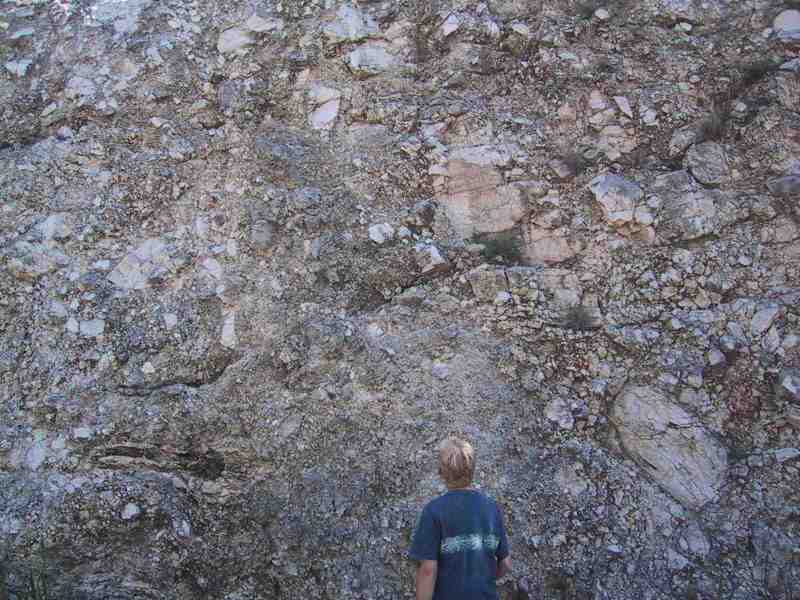

The following pictures show what happens when subsurface water dissolves away limestone. Ground water is like stomach acid (but not as strong, containing carbonic rather than hydrochloric acid) and limestone is essentially Tums (calcium carbonate). Tums dissolves in your stomach and neutralizes the acid. The next time you get excess acid, you have to take more Tums, because the tablets you took previously have dissolved away. Limestone, however, can't replace itself. This results in so-called collapse features described below.
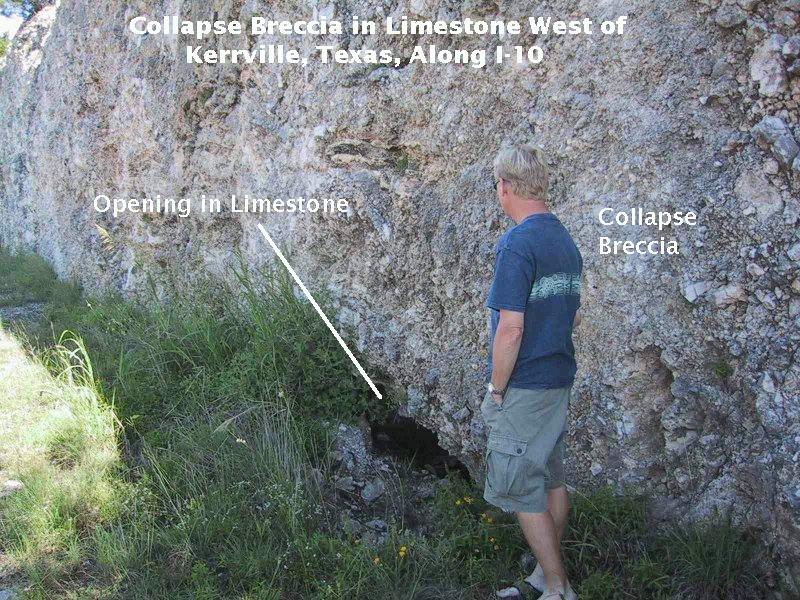
My brother is looking at a cavity in the limestone west of Kerrville along I-10. If you were to crawl into it, you might find a cave. Caves in limestone are formed when acidic ground water eats away the limestone, leaving a cavity - sort of like what happens when you don't exercise proper dental care. Note how broken up the limestone is in this road cut. It has lost support underneath due to the removal of limestone (and possibly associated evaporites) by ground water and has collapsed into a mess of angular limestone pieces. The rock that results from this process is called a "collapse breccia" (pronounced "breshia"). So, even though there might be a bit of a cave beyond the opening pictured, I would not venture in. Too dangerous. You want solid rock surrounding you in a cave, not breccia.
The following picture gives you an idea what the limestone looks like before it has the rug pulled out from under it. Even here, the loss of some subsurface support has caused the limestone to warp downward, producing a type of fold called a syncline.
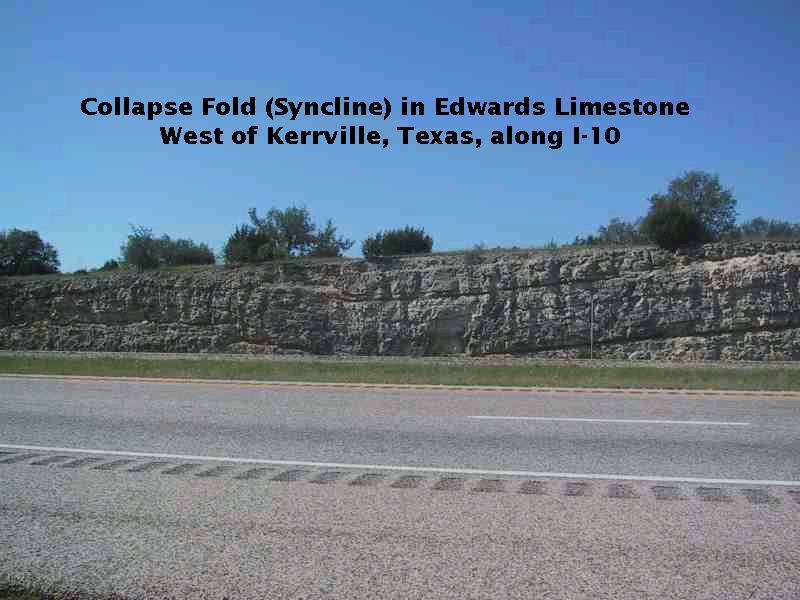
The limestone here is the Edwards Limestone of Lower Cretaceous age (about 105 million years old). It was laid down in an environment that included a shallow tropical sea and near-shore waters when North America was on the equator. The land was dominated by dinosaurs and the sea by marine reptiles. This limestone is found in the Edwards Plateau region - an area of land extending west of Austin and San Antonio, Texas, that was uplifted during the Cenozoic Era.
Below, you see the piece of a limestone bed that survived a collapse sufficiently well that it can still be recognized. It must have settled as a somewhat intact block as the rock gave way above an unseen cavity. Note the rock hammer provided for scale.
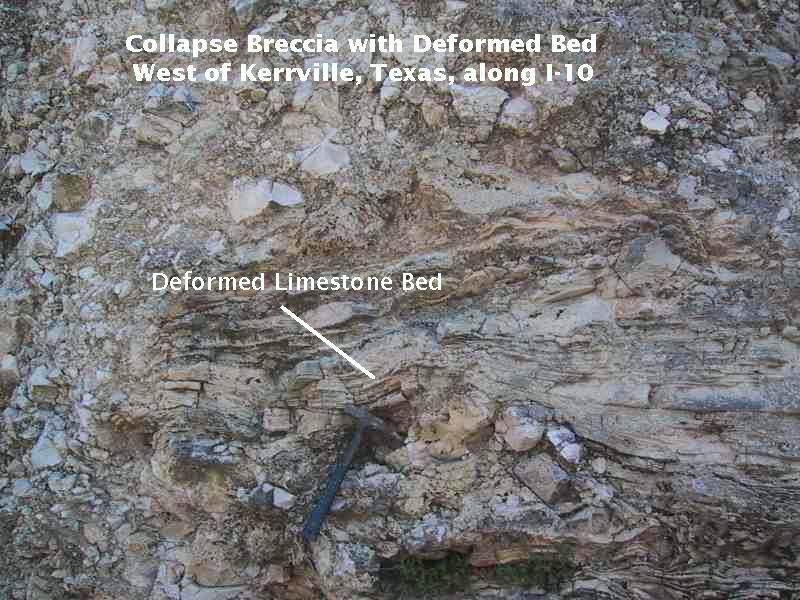
Much of the Edwards "limestone" has the appearance of being chert-like. Chert has the chemical composition of silica (one silicon atom for every two oxygen atoms) and, like quartz (also composed of silica), is extremely hard. It tends to fracture in curved surfaces reminiscent of shell shapes, hence the term conchoidal fracture, after the Greek word for mussel. Much of the Edwards Limestone has silica in the form of nodules or lenses. These nodules, such as the one pictured below, probably formed as silica from the spent tests (tiny shells) of microogranisms first dissolved and then condensed into a mass as the surrounding lime hardened into stone. A gradual recrystallization process then converted the silica to the fine-grained form of quartz called chert. The photograph below shows a lens of chert in the Edwards Limestone. If you look closely you can see some of the conchoidal-like fracturing in the breccia pieces.
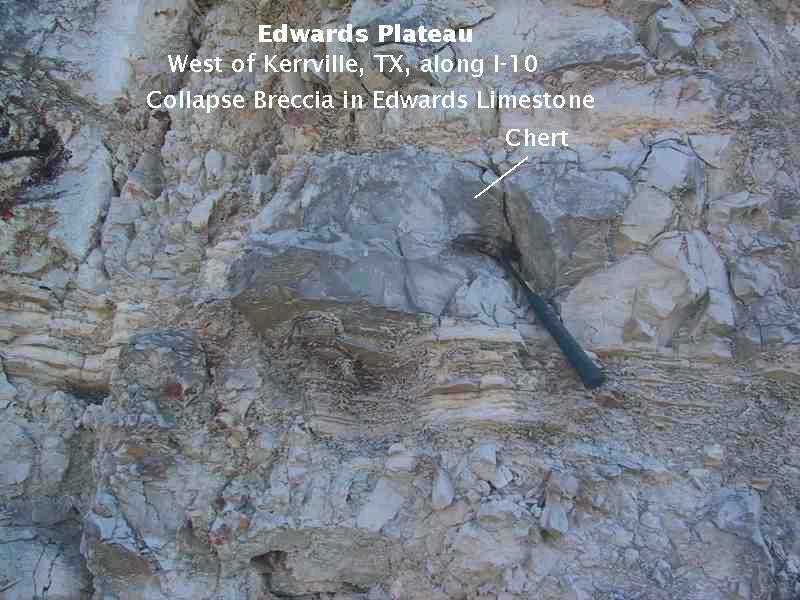
Breccia and folds aren't the only features that result from the collapse of limestone. A fold is a so-called structural feature, and another structural feature you often find is a fault, which is a fracture along which relative motion between the rock on either side of the fracture has taken place. (If no such movement occurs, the fracture is called a joint).
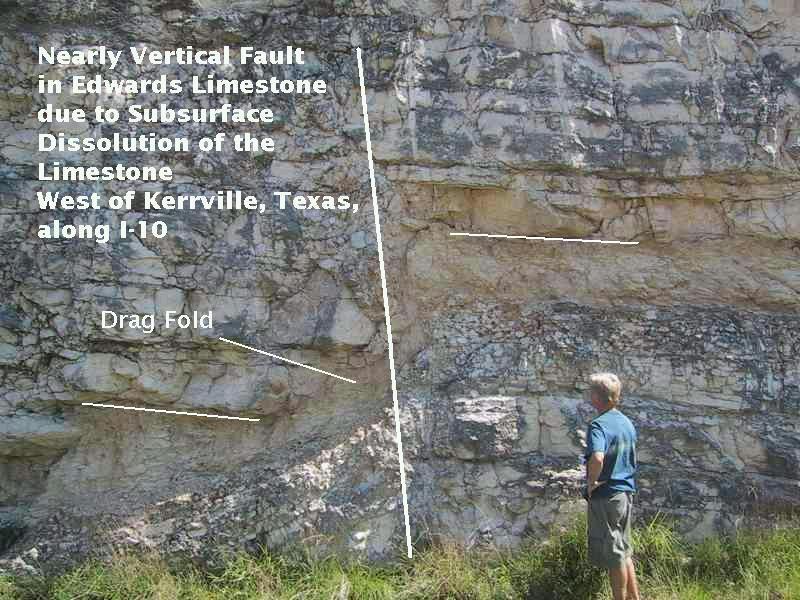
Above is a nearly vertical fault along which about a five-foot displacement has occurred. More rock was removed beneath the surface on the left-hand side compared to the right-hand side, resulting in this fault. The horizontal lines mark the base of a bed that has been displaced. Note the white bed that has been deformed as well as fractured but retains continuity, creating what is apparently a drag fold, a fold formed by the bed being dragged along by the fault motion. The bed below it also retains some continuity. Hence, this collapse may have occurred gradually in order to maintain some integrity of the beds and produce the drag fold. Nevertheless, the beds also show signs of "flow" due to their varying thickness, where the rock is fractured into pieces that move more like a liquid than an intact unit.
The picture below was taken looking across I-10 toward the rock corresponding to that in the previous picture. You see that the fault extended across the space excavated for the highway. The fault has clearly changed into what is called a normal fault. This is a fault where the hanging wall (on the right side of the image) has moved downward with respect to the foot wall (on the left). The shadows make it perhaps a bit difficult to see at first, but follow the same beds on either side of the fault, and you should see that the motion indicated by the arrows has occurred. If you look closely just above the roadbed, you can see that the fault actually dies out, at least locally, into another drag fold, where the beds were deformed plastically, with some liquid-like flow also occurring.
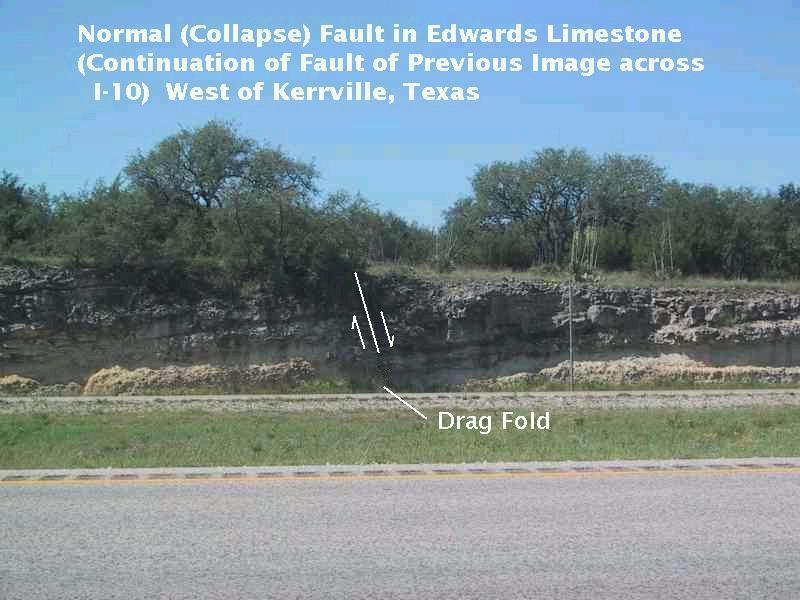
Not shown in any of these pictures are the marine shells (fossils) that you find from time to time in the limestone. Limestone forms when calcium carbonate (same chemical contained in Tums or Rolaids or other calcium carbonate-based antacid) precipitates out of seawater, usually with the help of marine organisms but sometimes directly, sort of like the salt that's left on your skin as your sweat evaporates. Warm water can't "hold" as much calcium carbonate as cold water, hence it tends to be deposited in warm seas. Marine organisms help by removing calcium carbonate from seawater to make their shells. Limestone usually consists, largely or wholly, from the accumulation of these shells, even though the forms of the shells themselves often have disappeared during the rock-forming ( diagenetic) process.
BACK to Contents
FORWARD to the Marathon uplift